The Theall Co. were classic Comstock era assayers, who branched out to many of the Nevada silver mining camps as news of their discoveries were announced to the public. H. W. Theall, born in New York in 1827, bought E. Justh’s assaying business in Marysville in 1859. At the time, his competition was the well known gold rush assaying firm of Harris Marchand, who later sold out to David Knight in 1863. Theall may have investigated the mining rushes at Unionville in 1861, Aurora in 1861-2, and Reese River in 1863. His contemporaries in Marysville certainly did, as Knight went from silver camp to silver camp, establishing assay offices in some, and working in others. Regardless, Theall had set up an assaying business in Virginia City, Nevada Territory by late 1862 or early 1863 on the corner of C and Taylor streets, right in the center of town. About this time, Theall may have opened a satellite assay office in Austin, the center of the then booming silver camps of the Reese River Region. During this booming period of the early 1860s, Theall lived in Virginia City, while his Marysville office was leased or managed by another person. His Austin office was later managed by A. Soderling, a well known assayer in Nevada mining camps, who later worked in such places as Bodie and Treasure Hill.
Theall’s business was so important to the financial infrastructure of the Comstock and Austin, that he took on as partners the bankers Paxton & Thornburgh, who were the major bankers in Austin and to a much lesser degree on the Comstock. When the White Pine rush attracted thousands of miners and businessmen to this remote eastern Nevada mining region in 1868, Theall was among them. He set up an assay office there, but sadly perished in May of 1869 from an unknown illness at the age of 42.
Nevada Assayer Hiram W. Theall is yet another important New Yorker who came to California for the Gold Rush. Though not associated, he joined the list of John L. Moffat, Augustus Humbert and a line of others who were New York merchants that left New York for the land of gold. Theall’s voyage to California was completely different than the others. He came west as a member of Stevenson’s Regiment for the Mexican War (Co. D, First Regiment, New York Volunteers), arriving March 6, 1847. The company disbanded in the fall of 1848.
Theall was part of a fairly large New York family. Born about 1817 to 1824 (he continually changed his birth date in various public records), he ran his own brokerage business in New York City in the early 1840’s as “H.W. Theall & Co.” at 4 Wall Street. He was one of thirteen Thealls listed in Doggett’s 1842 New York City Directory. Interestingly, Elias L. Theall was a druggist, another of the occupations that led some to become assayers in the West.
Theall Part of the Start of the California Gold Rush
The First Regiment of New York Volunteers played a major part in the California Gold Rush. It became well known to historians today because of the epic “Six Months in the Gold Mines” written by Lt. E. Gould Buffam, published in 1850. I have long stated that this is the finest written early work describing the first days of the gold rush. To find out that Theall was part of Buffam’s Party is nothing short of incredible.
Theall and Buffam came to California on the same ship, the Thomas H. Perkins. It was the first of three ships carrying the New York Volunteers. They disbanded Sept. 18, 1848 in Los Angeles. Buffam chronicled the adventure in great detail, noting how they mined ravines, removing pounds of gold, only to depart for another ravine to see if it held even more riches. Often they would return to a place of good gold only to find a mining camp had sprung up in their absence.
The men of Stevenson’s Regiment who went to the gold regions were many, and included the very first of the gold pioneers. Among them was Henry Angel (Angel’s Camp), Daniel and John Murphy (Murphy’s).
Theall Establishes Home in Sonora, California
The Buffam brigade, as I call it, seems to have disbanded from their gold activities in early 1849. Theall appears to have stayed on in Sonora. He voted in the first election in California June 3, 1849. Theall became the second Alcalde in Sonora when James Frazier stepped down (1849). Frazier was the man who named Sonora. Theall appears to have been a member of what may have been the first Vigilance committee (1849), though Edna Buckbee in “The Saga of Old Tuolumne” (1935) simply stated that he was “among the able and courageous men who dealt with (killings).” He was elected one of the first Alderman in Sonora in May, 1851. In the fall of 1851, Theall and two partners Perkins and Enyart, bought out the first general merchandise store in Sonora previously owned by Green & Holden. He became so well known that a street was named after him by 1852. Later, he was elected Postmaster in May, 1853 retaining that position through the end of 1854. In 1855 Theall moved to Forest City in Sierra County, staying there just a few months during the winter of 1855-1856. He became the Wells Fargo agent there, buying gold dust, issuing exchanges and handling Wells Fargo shipments. It is currently unknown if he was assaying the gold dust, or if he was sending it out to a local assayer, or simply forwarding it to one of the larger Wells, Fargo offices.
Theall Buys an Assay Firm, Justh & Hunter
Later in 1856, Theall moved to Marysville, where he remained with Wells Fargo through 1859 when he took over Justh & Hunter’s Marysville assay and bullion business early in the year. One of Theall’s competitors in Marysville was Harvey Harris. In 1860, Harris was off to the Comstock, where he soon established three assay offices. This must have had an impact on Theall, whose business was probably winding down as gold production near Marysville had begun to shrink in the early 1860’s. The prospects of opening offices in new mining regions to increase profits was a good concept, apparently championed by Harris.
Theall married Louisa Baker in Marysville in 1862, and the couple had a son (Henry Alexander) a year later. But tragedy struck, and Henry died after seven months.
Theall Explores Nevada
Theall may have had old friends in Virginia City in the early years of the Comstock. William W. Thayer was there, who was a druggist in New York City at the same time one of Theall’s relatives was a druggist. Regardless of the various ties, Theall made a trip to the Comstock perhaps late in 1862 and liked what he saw. In 1863 he opened his first assay office in Nevada Territory. Watching how Harris opened offices in new mining camps such as Aurora, Theall then opened an office in Austin at the onset of the Reese River Rush, managed by his associate J. M. Dawley.
In the early days of the Comstock, to survive as an assayer, you had to have contracts with producing mines. Theall lived near the Savage Mining Company’s office, and he probably had a contract with them. The Savage was producing bullion at a high level, so they used a number of assayers, checking the work of each, as well as checking the work of the custom mills that processed the ores. Another important association was with the banking industry. Gold Rush assayers often acted as banks. They bought and sold gold, converted gold to coin, and in this manner acted to assist in paying bills. As the banking industry developed through time in the West, the association of bank and assayer became critical. Theall became associated with Comstock bankers Paxton & Thornburgh. They rode that partnership to Austin, where Paxton & Thornburgh quickly became the main bank, and was the main bank for the largest silver producing company, the Manhattan Silver Mining Company.
Theall’s Austin Assay Office had a succession of operators. Dawley was followed by John Ramdohr, then Eugene Riotte, then Soderling. In November, 1865, he sold the Austin office to Boalt & Stetefeldt.
In 1866 Theall remarried to Susan Matthews.
As the 1860’s were coming to a close, mining was hitting hard times, and a general recession was well under way by late 1867. Theall sold his Virginia City office to W.C. Bousefield in February, 1868, the same month he sold the Marysville office. In an interesting business twist, he returned to his old, original business as a stock broker.
As Theall was settling into his brokerage business, another massive silver discovery was made in eastern Nevada. With it came the Rush to White Pine. Theall was tempted, and was off to Hamilton by late 1868. The White Pine Rush brought in 25,000 people by June 1869. Theall opened an assay office in Hamilton, the center of the region. Theall’s second son Julian was born in Hamilton in early 1869. Active in local politics, Theall was elected as a Hamilton School Trustee in April, 1869.
In May, 1869, at the height of the White Pine activity, Theall suddenly died. The obituaries did not reveal the cause of death. Small Pox and Pneumonia epidemics were in full swing at the time. In rural eastern Nevada, far from any civic center with a hospital, diseases were taking their toll. W.T. Jackson, In Treasure Hill (1963) wrote of the epidemics, which were white-washed by local press at the time. Theall may have been one of the victims, devastating the life of his wife and newborn son.
The landmark John J. Ford, Jr. Collection of Western Assay Bars, probably the finest collection ever formed, included a lone Theall ingot. That bar was silver, just 2.82 ounces and rather unremarkable in style. However, it did have some ornamental elements applied to the back.
There are currently only six Theall assayer ingots known today.
These are:
- 1) Theall & Co., 8.50 ozs with Tax Stamp
- 2) Theall & Co., 2.82 ozs, ornamental reverse for inscription;
- 3) Theall & Co., 18.05 ozs
- 4) Theall & Co., 1.05 ozs Silver Chamber Mine, Austin N.T. 9/20/1864
- 5) Theall & Co., 4.10 oz
- 6) Hamilton, Nev. Bar engraved to B.C. Lake, 6.50 ozs.
1.05z Oz Theall Co Silver Chamber Mine Silver Ingot.
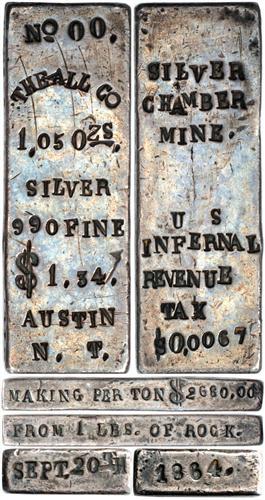
The Silver Chamber Mine is located on Union Hill in the Reese River district near Austin, Nevada. It was located in 1863, along with more than 1000 other mining claims as part of the Reese River Silver Rush that year. Little work was done the first year; indeed, the mine is not mentioned in the fist six months of 1864 in the Mining and Scientific Press. Prospecting continued at the Silver Chamber for a number of years. It is not listed with official production in 1865, 1866, or 1867. In the second and third quarters of 1868, the mine produced $8200 from 28 tons of ore, indicating the very high value and richness of the ores of nearly $300 per ton.
The mine was patented (taken private) before the end of the decade and by 1869 had a 385-foot deep inclined shaft accessing the underground ores, according to Ross Raymond in Mineral Statistics West of the Rocky Mountains, 1870. Work had been suspended toward the end of 1869. Through July of that year, only 22 tons of ore had been mined that paid $7166. The ore was, however, excessively rich, worth nearly $350 per ton in silver. Later news of the Silver Chamber is absent from the historical record. The Manhattan Silver Mining Company bought many of the good producing mines of Reese River, consolidating them into a single company. The Silver Chamber may have been one of these.
This small ingot marked with the Silver Chamber Mine name and the Nevada Territorial (N.T.) designation is the only Territorial-marked Nevada ingot in existence to the knowledge of the author (Fred Holabird). It probably represents a first production product made just after discovery, and was perhaps used to help raise money through the sale of stock. Many (if not most) of the mines in the Reese River District were financed in New York, and the Silver Chamber was probably no exception.
Ingots such as this were on exhibit at the 1867 Paris International Exhibition. In that large exhibition, Nevada ores played a prominent role. Located just outside the main exhibit grounds because of a late arrival, more than 50 different specimens from Reese River ores and a few ingots were on display, though this is not known to be one of them.
This ingot is a product of Theall Co., whose imprint is on the top of the front side.
The small rectangular ingot has imprinting on all six sides.
The top side reads: NO 00. /THEALL CO / 1.05 Ozs / SILVER / 990 FINE / $1.54. / AUSTIN / N.T. The back side reads: SILVER CHAMBER MINE / U S / INTERNAL / REVENUE / TAX / $0.0067. The short sides read: SEPT 20TH and 1864. The long sides read: MAKING PER TON $2680.00 and FROM 1 LBS. OF ROCK.
A fascinating and undoubtedly unique piece of Western Americana.
From The Alan Bingel Collection.
[07/2005] https://coins.ha.com/itm/territorial-gold/silver-chamber-mine-silver-ingot-the-silver-chamber-mine-is-located-on-union-hill-in-the-reese-river-district-near-austin-/a/382-10481.s ($13,800)
503.5 grains (32.62 grams, or nearly precisely 1.05 troy ounces as marked). 42.4 x 14.5 x 5.4 mm. No. 00. A marvelous little presentation bar from the Nevada Territory, carefully marked on each face. The front reads, in single letter punches: No. 00 / (curved) THEALL CO / 1.05 0zs / SILVER / 990 FINE / $ 1.34 / AUSTIN / N.T. The back face reads: SILVER / CHAMBER / MINE. / US / INFERNAL ( sic! ) / REVENUE / TAX / $0.oo67 — a humorous reference to what Fred Holabird and Bob Evans refer to as “the dreaded bullion tax,” which first went into effect in September 1864. The left side face reads: MAKING PER TON $ 2680.00 and the right side face reads: FROM 1 LBS. OF ROCK. The top face is dated: SEPT 20TH and the bottom face completes the date: 1864. The bar is deep silver gray with faint blue and gold toning, shows evidence of perhaps a light polishing long ago, shows a few lengthwise old scratches on the top face, and some light signs of handling. The recent study on Western assay ingots by Fred Holabird and Bob Evans, published in an attempt to clear up the confusion between genuine products of the old West and modern forgeries, stated, “Presentation ingots were made for commemorating an event such as a first mill product or pour, or honoring an individual such as a mine superintendent or financier.” It appears that such is the case with this humorously inscribed diminutive silver bar, issued on a precise date to commemorate the goodly amount of silver derived from one pound of rock from the Silver Chamber Mine, a deposit near Austin in Lander County, Nevada—it was clearly an incredibly rich vein, as modern mines yield only several ounces of silver per ton! The timing was coincidental with the introduction of the bullion tax mandated by the Act of June 30, 1864, which is known to have taken affect in California on September 2 and “in a similar time period” in Nevada according to Holabird and Evans. At the rate of 1/20th of 1%, the tax on an ingot worth $1.34—a tiny amount in comparison to most large gold or silver ingots—was $0.00067, the amount named on this ingot as the “infernal” revenue tax in a show of obvious jocularity. The producer of this ingot was an experienced assayer who had first made a name in the California gold fields. Described in detail in Dan Owens’ California Coiners and Assayers, H.W. Theall succeeded Justh & Hunter (who produced a number of the bars found in the treasure of the S.S. Central America) in Marysville, California in 1859 and moved to Virginia City, Nevada in 1863. The same year the central Nevada town of Austin on the Reese River experienced a silver boom, and the Theall & Co. assay office is noted as having opened in Austin by April 1864. Theall died in 1869 and was succeeded by Van Wyck & Co., producers of an unparted ingot that realized $11,000 in Stack’s 2003 Americana sale.
Nevada became the 36th state on October 31, 1864—a little over a month after the date on this ingot.
Provenance: Long held by a family whose ancestor had settled in the early West, this piece made its first appearance in the numismatic marketplace at the September 2003 Cincinnati show.
[01/2004] https://auctions.stacksbowers.com/lots/view/3-AN6K0/austin-nevada-territory-theall-co-silver-ingot-september-20-1864-105-ounces ($5,980)
[01/2004] https://archive.org/details/classicssalethom2004amer_r0e8/page/42/
(Ca. 1869) 8.5 oz Theall & Co. Silver Ingot.
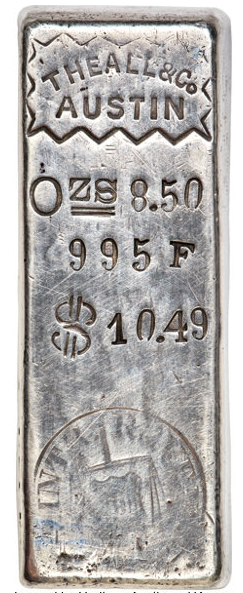
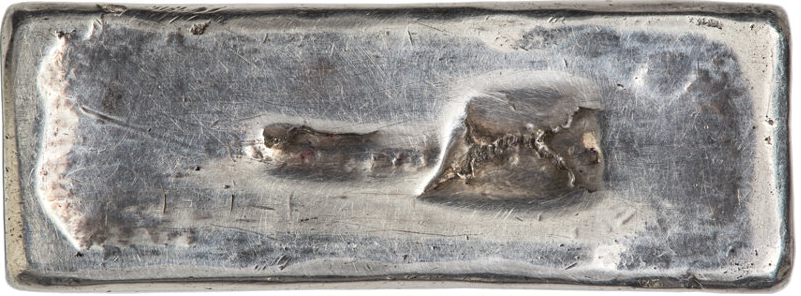

Theall & Company were Comstock assayers who branched out to many of the Nevada silver mining camps as news of discoveries were announced to the public. H.W. Theall lived in Virginia City, while his Marysville office was leased or managed by someone else. His Austin office was later managed by A. Soderling, a well-known assayer in Nevada mining camps. Theall’s business was so important to the financial infrastructure of the Comstock and Austin that he took on as partners the bankers Paxton & Thornburgh, major bankers in Austin. The above background information was taken from Fred Holabird’s 2008 book The Rush for Gold! For those who wish to take a deeper dive into smaller Territorial assayers we highly recommend Fred’s book.
The top side of the ingot displays the hallmark of THEALL & Co / AUSTIN / Ozs 8.50 / 995 F / $10.49 / Internal Revenue stamp (lightly impressed). One of the long sides has the stamp METTACOM. Mettacom was a silver mining company located on Lander Hill, next to the Florida Mine. It was a regularly producing mine from 1866-1869. The ingot is bright on all sides from obvious cleaning.
[06/2021] https://coins.ha.com/itm/ingots/-ca-1869-theall-and-co-silver-ingot-850-ounces/a/1331-3258.s ($11,400)
4.10 Oz Theall & Co., Austin. Nevada Territory Silver Ingot. .995 Fine. $5.27 Face Value

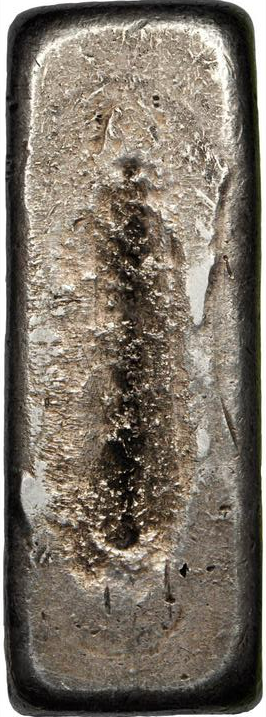
63 mm x 32 mm x 9 mm. Deep silver-gray with steel and slate highlights. Marked on just one of its six sides with a saw-toothed rectangle at the top, THEALL & Co arcing above AUSTIN within, OZ 4.10 / 995 FINE / $5.27 at center on three lines, circular seal at bottom, U.S. INTR. REVENUE around shield and balance with six-pointed star at bottom of shield, all within circle. Back side with casting voids, scattered marks here and there including minor rim bruises, though no single mark demands our written description. Probably from ore from the Silver Chamber Mine, a deposit near Austin in Lander County, Nevada.
As noted in detail in Dan Owens’ California Coiners and Assayers, the producer of this ingot was an experienced assayer who had first made a name in the California gold fields. H.W. Theall succeeded Justh & Hunter (who produced a number of the gold bars found in the treasure of the S.S. Central America) in Marysville, California in 1859 and moved to Virginia City, Nevada in 1863. The same year the central Nevada town of Austin on the Reese River experienced a silver boom, and the Theall & Co. assay office is noted as having opened in Austin by April 1864. Theall died in 1869 and was succeeded by Van Wyck & Co., producers of an unparted ingot that realized $11,000 in Stack’s 2003 Americana sale. In our January 2004 sale of the Thomas H. Sebring Collection, Lot 125, we sold a small — 1.05 ounces — presentation ingot from Theall & Co.; at that time we noted: “we have records of no other ingots from H.W. Theall, an assayer mourned as “an estimable man” who left a wife and child when he died at the age of 42.” That particular Theall ingot realized $5,980.
[08/2012] https://auctions.stacksbowers.com/lots/view/3-30D6W/nevada-territory-silver-ingot-theall-co-austin-410-ounces-995-fine-527-face-value-contemporary-value ($14,100)
2.82 oz Theall and Co. Marysville, California or Virginia City, Nevada Territory. Silver assay ingot.
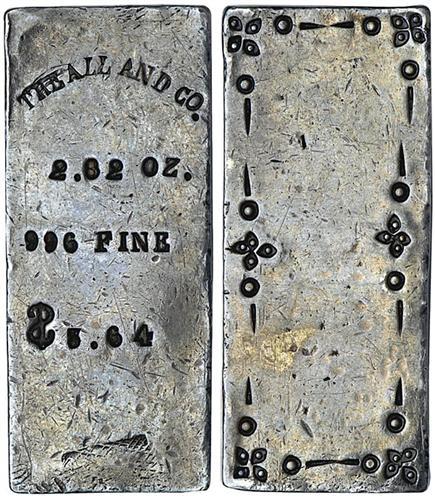
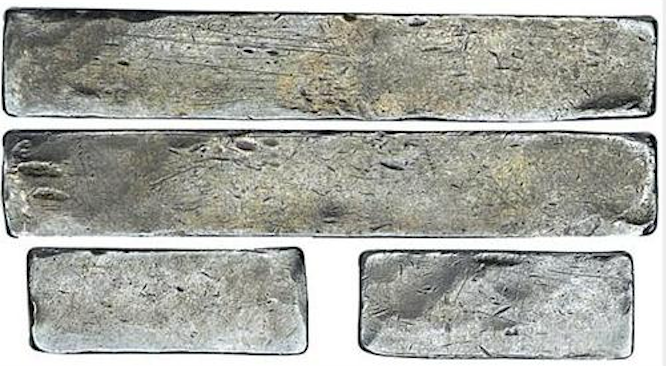
Overall appearance of Very Fine. A small, dark, and not terribly impressive ingot at first glance. Fairly well made, with squared off edges, sharp corners, and faces that had been polished. The ethnic appears to be by individual punches as are the numerals, OZ, and FINE stamps. The back shows an ornamental border composed of individual punches and looks as if it had been intended to receive an inscription. This bar may have been meant as a presentation ingot that was either never finished if ordered or never sold as such. Theall’s ingots are extremely rare and this was the only example Mr. Ford had in his collection. The absence of the OIR stamp most likely dates the bar to the period 1859 to just before 1865 and places its manufacture either in Marysville, California or Virginia City, Nevada Territory. Since Theall died in May, 1869 it is just possible the bar was made in Hamilton, Nevada early that year. An exceptionally interesting Theall bar that appeared in American Numismatic Rarities’ sale of January, 2004 (lot 125) was dated September 20, 1864 and bore a tax paid inscription accomplished in individual punches. H.W. Theall (given name unknown) was a native of New York City born in 1827. He arrived in California when in his late 20s and settled in Marysville, where he opened an assay office in the old premises of Justh & Hunter in 1859. Four years later he expanded his business into Virginia City, later into Austin and Hamilton, Nevada. Other, less well known assayers whose names appear on some rare ingots worked for Theall at one time in their careers, including Soderling and Bousfield. The firm of Van Wyck & Company succeeded to Theall’s business on his death in 1869.
- Face: THEALL AND CO. / 2.82 OZ. / 996 FINE / $5.64.
- Back: ornamental border.
- Top side: blank.
- Bottom side: blank.
- Left side: blank.
- Right side: blank.
- Dimensions: 49.5 x 21.0 x 8.2 mm.
- Current weight: 90.31 gms.
From the John J. Ford, Jr. Collection
Provenance: Mr. Ford’s informational card that accompanies the lot records this as in the Kagin Collection on December 14, 1957.
[10/2007] https://auctions.stacksbowers.com/lots/view/3-AV6QF/theall-and-company-marysville-california-or-virginia-city-nevada-territory-silver-assay-ingot ($32,200)
18.05 oz H.W. Theall & Co. Ingot. Mixed Metal, Gold (.063 fine) and Silver (.899 fine). Marysville, California or Virginia City, Nevada Territory. No. 2700. $23.50 Gold, $20.98 Silver. c1864
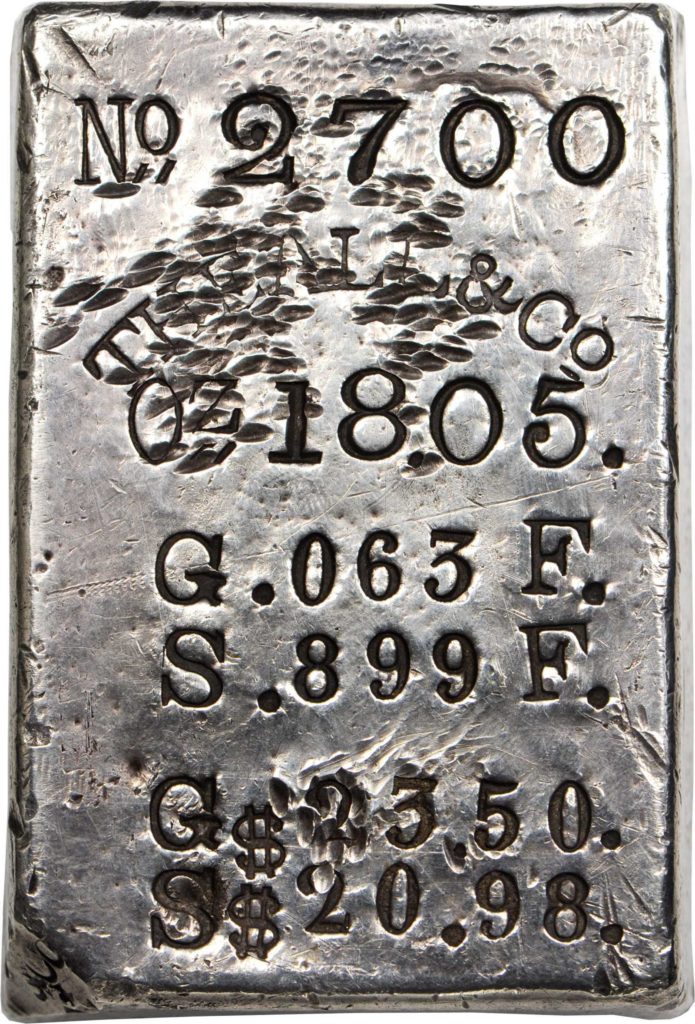
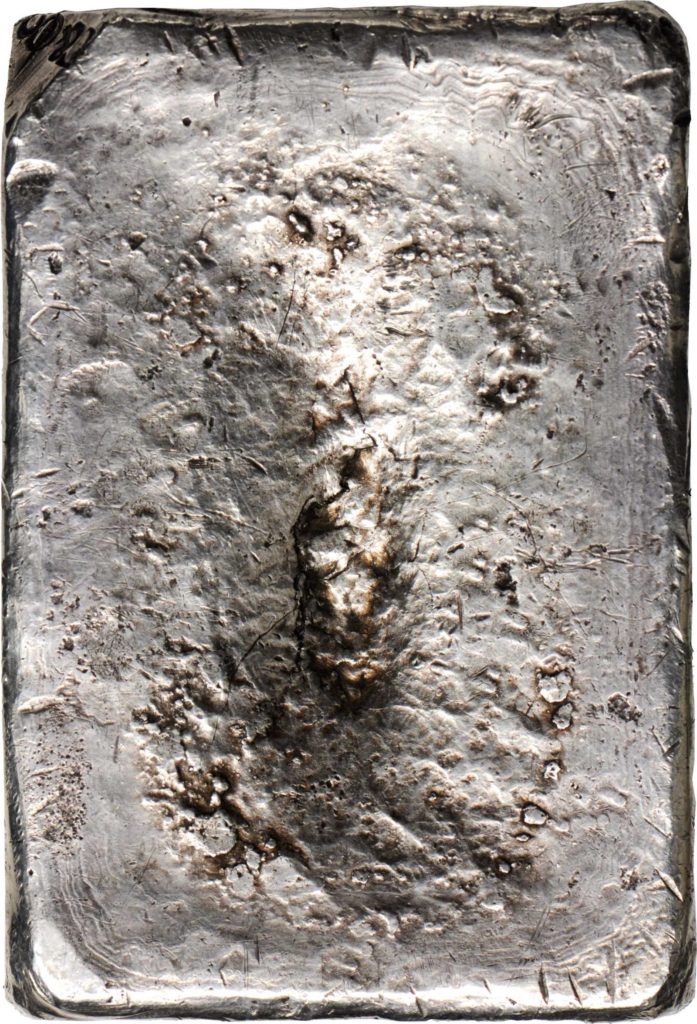
67 mm x 45.5 mm x 19 mm. A remarkable specimen from this rarely represented assayer and the largest Theall ingot we have seen by a wide margin. The face marked with the usual information of number, weight, composition and value in individual letter punches. The assayer’s identity is placed in the upper half, just below the number, applied by a curved gang-punch. Assay corner cuts seen at two opposing corners, one at the lower left of the face. Each is marked with a partial punch from the end of a larger gang-punch, appearing to end with “T&Co.” The back of the bar with a typical broad and rough cooling depression. Scattered casting imperfections and handling marks, as expected for a large work-horse bar created solely for accounting and transportation purposes. This being in contrast to smaller decorative bars, often inscribed, that were created or sold as presentation pieces. While those might have a little extra in terms of charm, they were intended to be saved as precious mementos, while bars like this one were intended for eventual destruction making the survival of this one all the more remarkable. An unfortunate series of surface marks are concentrated at the name of the assayer, but enough is visible to identify it with ease as product of one of Theall’s shops.
The present bar is likely from the first few years of Theall’s activity as an assayer, placing it in the 1859-1864 span. H.W. Theall (given name unknown) was a native of New York City born in 1827. He arrived in California when in his late 20s and settled in Marysville, where he opened an assay office in the old premises of Justh & Hunter in 1859. Four years later he expanded his business into Virginia City, later into Austin and Hamilton, Nevada. Other, less well known assayers whose names appear on some rare ingots worked for Theall at one time in their careers, including Soderling and Bousfield. The firm of Van Wyck & Company succeeded to Theall’s business on his death in 1869.
This ingot weighs 18.05 troy ounces, and is the largest of the six known Theall ingots by three fold. It is 899 fine silver, 063 fine gold, valued at $20.98 silver and $23.50 gold. It is the classic rectangular shape so commonly used by standard assayers, and marked clearly with “Theall & Co.” in a curved line at the top with no apparent city designation in a straight line underneath, as is marked a Theall ingot from Hamilton. It is a classic western assayer’s bullion punch.
The presence of gold in this ingot is typical of the Comstock ingots and of the Comstock mining region. Theall’s other Nevada assay office in Austin would have produced assay bars of much higher fineness in silver, as the ore deposits there are completely different than those of the Comstock.
This bar has the Theall punch partially defaced. There could be a number of reasons, but none would have called his credibility into account, or the ingot would have hit the melting pot. Speculation for the marks is beyond the scope of this paper.
[04/2015] https://www.icollector.com/A-Rare-Virginia-City-Nevada-Theall-Silver-Ingot-c1864_i21872738 ($18,987)
